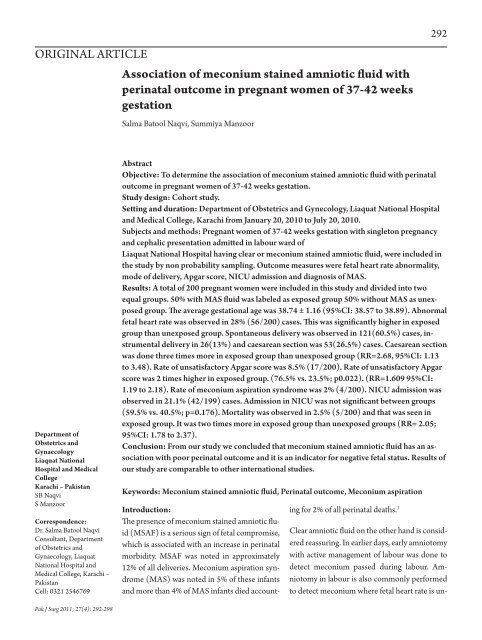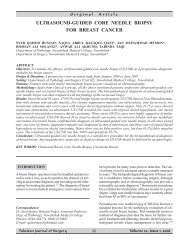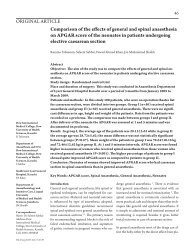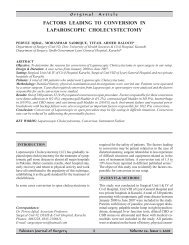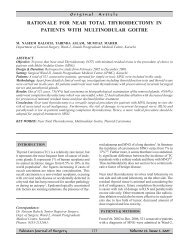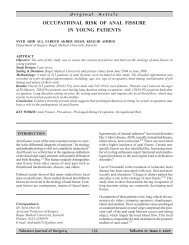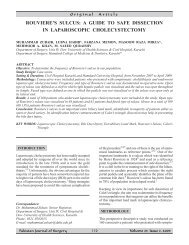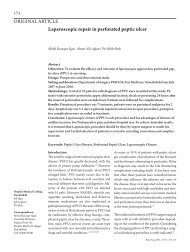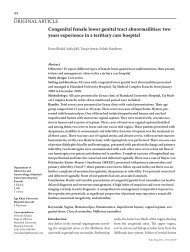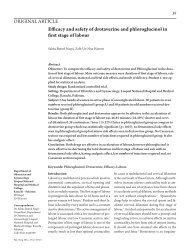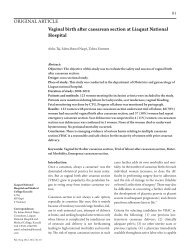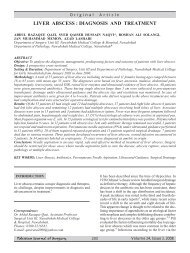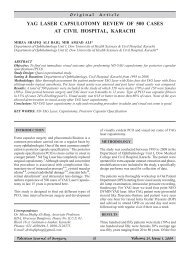Association of meconium stained amniotic fluid with perinatal ...
Association of meconium stained amniotic fluid with perinatal ...
Association of meconium stained amniotic fluid with perinatal ...
You also want an ePaper? Increase the reach of your titles
YUMPU automatically turns print PDFs into web optimized ePapers that Google loves.
ORIGINAL ARTICLE<br />
<strong>Association</strong> <strong>of</strong> <strong>meconium</strong> <strong>stained</strong> <strong>amniotic</strong> <strong>fluid</strong> <strong>with</strong><br />
<strong>perinatal</strong> outcome in pregnant women <strong>of</strong> 37-42 weeks<br />
gestation<br />
Salma Batool Naqvi, Summiya Manzoor<br />
292<br />
Department <strong>of</strong><br />
Obstetrics and<br />
Gynaecology<br />
Liaquat National<br />
Hospital and Medical<br />
College<br />
Karachi – Pakistan<br />
SB Naqvi<br />
S Manzoor<br />
Correspondence:<br />
Dr. Salma Batool Naqvi<br />
Consultant, Department<br />
<strong>of</strong> Obstetrics and<br />
Gynaecology, Liaquat<br />
National Hospital and<br />
Medical College, Karachi –<br />
Pakistan<br />
Cell: 0321 2546769<br />
Abstract<br />
Objective: To determine the association <strong>of</strong> <strong>meconium</strong> <strong>stained</strong> <strong>amniotic</strong> <strong>fluid</strong> <strong>with</strong> <strong>perinatal</strong><br />
outcome in pregnant women <strong>of</strong> 37-42 weeks gestation.<br />
Study design: Cohort study.<br />
Setting and duration: Department <strong>of</strong> Obstetrics and Gynecology, Liaquat National Hospital<br />
and Medical College, Karachi from January 20, 2010 to July 20, 2010.<br />
Subjects and methods: Pregnant women <strong>of</strong> 37-42 weeks gestation <strong>with</strong> singleton pregnancy<br />
and cephalic presentation admitted in labour ward <strong>of</strong><br />
Liaquat National Hospital having clear or <strong>meconium</strong> <strong>stained</strong> <strong>amniotic</strong> <strong>fluid</strong>, were included in<br />
the study by non probability sampling. Outcome measures were fetal heart rate abnormality,<br />
mode <strong>of</strong> delivery, Apgar score, NICU admission and diagnosis <strong>of</strong> MAS.<br />
Results: A total <strong>of</strong> 200 pregnant women were included in this study and divided into two<br />
equal groups. 50% <strong>with</strong> MAS <strong>fluid</strong> was labeled as exposed group 50% <strong>with</strong>out MAS as unexposed<br />
group. The average gestational age was 38.74 ± 1.16 (95%CI: 38.57 to 38.89). Abnormal<br />
fetal heart rate was observed in 28% (56/200) cases. This was significantly higher in exposed<br />
group than unexposed group. Spontaneous delivery was observed in 121(60.5%) cases, instrumental<br />
delivery in 26(13%) and caesarean section was 53(26.5%) cases. Caesarean section<br />
was done three times more in exposed group than unexposed group (RR=2.68, 95%CI: 1.13<br />
to 3.48). Rate <strong>of</strong> unsatisfactory Apgar score was 8.5% (17/200). Rate <strong>of</strong> unsatisfactory Apgar<br />
score was 2 times higher in exposed group. (76.5% vs. 23.5%; p0.022). (RR=1.609 95%CI:<br />
1.19 to 2.18). Rate <strong>of</strong> <strong>meconium</strong> aspiration syndrome was 2% (4/200). NICU admission was<br />
observed in 21.1% (42/199) cases. Admission in NICU was not significant between groups<br />
(59.5% vs. 40.5%; p=0.176). Mortality was observed in 2.5% (5/200) and that was seen in<br />
exposed group. It was two times more in exposed group than unexposed groups (RR= 2.05;<br />
95%CI: 1.78 to 2.37).<br />
Conclusion: From our study we concluded that <strong>meconium</strong> <strong>stained</strong> <strong>amniotic</strong> <strong>fluid</strong> has an association<br />
<strong>with</strong> poor <strong>perinatal</strong> outcome and it is an indicator for negative fetal status. Results <strong>of</strong><br />
our study are comparable to other international studies.<br />
Keywords: Meconium <strong>stained</strong> <strong>amniotic</strong> <strong>fluid</strong>, Perinatal outcome, Meconium aspiration<br />
Introduction:<br />
The presence <strong>of</strong> <strong>meconium</strong> <strong>stained</strong> <strong>amniotic</strong> <strong>fluid</strong><br />
(MSAF) is a serious sign <strong>of</strong> fetal compromise,<br />
which is associated <strong>with</strong> an increase in <strong>perinatal</strong><br />
morbidity. MSAF was noted in approximately<br />
12% <strong>of</strong> all deliveries. Meconium aspiration syndrome<br />
(MAS) was noted in 5% <strong>of</strong> these infants<br />
and more than 4% <strong>of</strong> MAS infants died accounting<br />
for 2% <strong>of</strong> all <strong>perinatal</strong> deaths. 1<br />
Clear <strong>amniotic</strong> <strong>fluid</strong> on the other hand is considered<br />
reassuring. In earlier days, early amniotomy<br />
<strong>with</strong> active management <strong>of</strong> labour was done to<br />
detect <strong>meconium</strong> passed during labour. Amniotomy<br />
in labour is also commonly performed<br />
to detect <strong>meconium</strong> where fetal heart rate is un-<br />
Pak J Surg 2011; 27(4): 292-298
293<br />
satisfactory. If <strong>meconium</strong> <strong>stained</strong> <strong>amniotic</strong> <strong>fluid</strong><br />
(MSAF) is found, then continuous fetal heart<br />
rate monitoring (Cardiotocography CTG) is required<br />
for fetal well being. 2,3,4<br />
The exact etiology <strong>of</strong> MSAF remains unclear 5 .<br />
Previous studies have demonstrated that the<br />
incidence <strong>of</strong> MSAF rises <strong>with</strong> gestational age<br />
reaching as high as 30% in post term pregnancies.<br />
In utero, <strong>meconium</strong> passage rarely occurs<br />
before 32 weeks <strong>of</strong> gestation 6,7 and most babies<br />
<strong>with</strong> <strong>meconium</strong> <strong>stained</strong> <strong>amniotic</strong> <strong>fluid</strong> are<br />
37weeks or older 8 .<br />
MAS is more frequently seen in post term pregnancy<br />
or in growth restricted fetuses. An increased<br />
incidence <strong>of</strong> <strong>meconium</strong> passage into the<br />
<strong>amniotic</strong> cavity is also noted in the presence <strong>of</strong><br />
fetomaternal stress factors such as hypoxia and<br />
infection, independent <strong>of</strong> fetal maturation 9 .<br />
Factors such as placental insufficiency, maternal<br />
hypertension, pre-eclampsia, oligohydromnios<br />
or maternal drug abuse (tobacco or cocaine)<br />
also result in, in utero passage <strong>of</strong> <strong>meconium</strong>. 10<br />
Meconium itself may have potentially detrimental<br />
effects on fetal tissues and organs, although<br />
fetuses <strong>with</strong> <strong>meconium</strong> <strong>stained</strong> <strong>amniotic</strong> <strong>fluid</strong><br />
are commonly born <strong>with</strong>out any adverse sequelae.<br />
Among the adverse effects, <strong>meconium</strong> in the<br />
<strong>amniotic</strong> <strong>fluid</strong> has been suggested to stimulate<br />
umbilical vessel constriction, vessel necrosis,<br />
and production <strong>of</strong> thrombi, potentially associated<br />
<strong>with</strong> ischemic cerebral palsy. Meconium<br />
alters the level <strong>of</strong> zinc in <strong>amniotic</strong> <strong>fluid</strong>, which<br />
may reduce the antibacterial properties and possibly<br />
facilitate intra-<strong>amniotic</strong> infections. In the<br />
presence <strong>of</strong> fetal stress such as hypoxia, the gasping<br />
actions <strong>of</strong> the fetus may aspirate <strong>meconium</strong><br />
into its lungs where <strong>meconium</strong> may neutralize<br />
the action <strong>of</strong> surfactant and promote lung tissue<br />
inflammation by activating neutrophils and<br />
macrophages. 11 In the presence <strong>of</strong> continued hypoxia<br />
after birth, aspirated <strong>meconium</strong> may contribute<br />
to pulmonary vascular hypertrophy and<br />
possibly pulmonary hypertension.<br />
Meconium has been associated <strong>with</strong> additional<br />
SB Naqvi, S Manzoor<br />
adverse events increased preterm labor, altered<br />
coagulation pr<strong>of</strong>ile in the fetus, and neonatal<br />
seizures. Although the direct and indirect effects<br />
remain uncertain, <strong>meconium</strong> <strong>stained</strong> <strong>amniotic</strong><br />
<strong>fluid</strong> is consistently identified as a predictor <strong>of</strong><br />
maternal and <strong>perinatal</strong> complications. 1<br />
The incidence <strong>of</strong> <strong>meconium</strong> <strong>stained</strong> <strong>amniotic</strong><br />
<strong>fluid</strong> has remained approximately 12% since the<br />
last century. However, the incidence <strong>of</strong> MAS has<br />
decreased markedly during the past 20 years. Yoder<br />
et al. 12 reported a nearly 4-fold decrease in<br />
the incidence <strong>of</strong> MAS from 1990-1992 to 1997-<br />
1998, possibly as a result <strong>of</strong> early induction, liberal<br />
use <strong>of</strong> amnioinfusion, and increased caesarean<br />
section rate. Although there are recommended<br />
intrapartum and postpartum clinical strategies<br />
for the prevention <strong>of</strong> MAS, 12,13 autopsy studies<br />
suggest that mostly <strong>meconium</strong> aspiration occurs<br />
in utero. Thus the prevention <strong>of</strong> fetal passage <strong>of</strong><br />
<strong>meconium</strong> into <strong>amniotic</strong> <strong>fluid</strong>, understanding <strong>of</strong><br />
the mechanism <strong>of</strong> clearance <strong>of</strong> <strong>meconium</strong> from<br />
the <strong>amniotic</strong> <strong>fluid</strong> and knowledge <strong>of</strong> the multiple<br />
factors contributing to MAS are essential<br />
to design therapeutic approaches for prevention<br />
<strong>of</strong> MAS.<br />
The present study is undertaken in the representative<br />
sample from the urban population <strong>of</strong><br />
Pakistan presented to a private tertiary care hospital<br />
<strong>of</strong> Karachi (Liaquat National Hospital). It<br />
will help to confirm the worldwide statistics in<br />
this population. It will also help in modification<br />
<strong>of</strong> obstetric decisions (like early induction <strong>of</strong><br />
labour after 37 weeks gestation, caesarean or instrumental<br />
deliveries) in the light <strong>of</strong> the results.<br />
And also generalizing the modified procedures<br />
in sister organizations or elsewhere.<br />
Material and methods:<br />
This cohort study was conducted in Obstetrics<br />
& Gynaecology unit <strong>of</strong> Liquat National Hospital,<br />
Karachi, from 20th Jan 2010 to 20th July 2010.<br />
The inclusion criteria for this study was pregnant<br />
women <strong>of</strong> 18-40 years age <strong>with</strong> singleton<br />
pregnancy between 37-42 weeks gestation and<br />
cephalic presentation. Patients <strong>with</strong> antepartum<br />
haemorrahage, diabetes mellitus or hyperten-<br />
Pak J Surg 2011; 27(4): 292-298
<strong>Association</strong> <strong>of</strong> <strong>meconium</strong> <strong>stained</strong> <strong>amniotic</strong> <strong>fluid</strong> <strong>with</strong> <strong>perinatal</strong> outcome in pregnant women <strong>of</strong> 37-42 weeks gestation<br />
Pak J Surg 2011; 27(4): 292-298<br />
sion were excluded from the study.<br />
Study was carried out to determine the association<br />
<strong>of</strong> <strong>meconium</strong> <strong>stained</strong> <strong>amniotic</strong> <strong>fluid</strong> <strong>with</strong><br />
<strong>perinatal</strong> outcome in pregnant women <strong>of</strong> 37-42<br />
weeks gestation. All these women presenting at<br />
any stage <strong>of</strong> labour and meeting the selection<br />
criteria were selected by the on duty RMO (year<br />
3 resident) and divided into two groups on the<br />
basis <strong>of</strong> presence or absence <strong>of</strong> <strong>meconium</strong>.<br />
Group <strong>with</strong> <strong>meconium</strong> <strong>stained</strong> <strong>amniotic</strong> <strong>fluid</strong><br />
was labeled as exposed while the other group<br />
<strong>with</strong> clear or <strong>meconium</strong> free <strong>amniotic</strong> <strong>fluid</strong> was<br />
labeled as unexposed. The purpose, procedure,<br />
risks and benefits <strong>of</strong> the study were explained to<br />
patients and consent obtained from patients by<br />
duty RMO. The course <strong>of</strong> labour was observed<br />
and any fetal heart rate abnormality detected by<br />
CTG, mode <strong>of</strong> delivery, Apgar score at 1 minute<br />
after birth was recorded on study pr<strong>of</strong>orma.<br />
All neonates were seen by a Paediatric RMO.<br />
Presence or absence <strong>of</strong> <strong>meconium</strong> aspiration<br />
was confirmed by presence <strong>of</strong> <strong>meconium</strong> below<br />
the vocal cords on laryngoscopic examination<br />
<strong>of</strong> neonates born through <strong>meconium</strong>. In addition<br />
both mother and neonate were followed up<br />
during their stay in postnatal ward or neonatal<br />
ICU in case <strong>of</strong> admission for upto 1 week. All<br />
data was entered on pr<strong>of</strong>orma by the attending<br />
doctor.<br />
Data was analysed using a statistical package<br />
for social sciences (SPSS Version 11). Data<br />
was entered into spreadsheet (Excel; Micros<strong>of</strong>t<br />
Inc, Redmond, WA) over the course <strong>of</strong> study.<br />
The quantitative variable gestational age was<br />
computed in mean and standard deviation and<br />
analyzed by independent student t test. The outcome<br />
variables were computed for frequency<br />
and percentage like fetal heart rate abnormality,<br />
mode <strong>of</strong> delivery, Apgar condition, <strong>meconium</strong><br />
aspiration syndrome, NICU admission and<br />
mortality for exposed and unexposed groups<br />
and analyzed by chi-square test. Relative risks<br />
were also computed <strong>with</strong> 95% confidence interval.<br />
P values <strong>of</strong> more than .05 were considered<br />
not significant.<br />
294<br />
Results:<br />
A total <strong>of</strong> 200 pregnant women <strong>of</strong> 37 to 42 weeks<br />
gestation <strong>with</strong> singleton pregnancy and cephalic<br />
presentation were included in this study. Women<br />
were divided into two groups. Hundred women<br />
<strong>with</strong> <strong>meconium</strong> <strong>stained</strong> <strong>amniotic</strong> <strong>fluid</strong> were<br />
labeled as exposed group while other women<br />
<strong>with</strong>out <strong>meconium</strong> <strong>stained</strong> <strong>amniotic</strong> <strong>fluid</strong> were<br />
unexposed group. The average gestational age<br />
was 38.74 ± 1.16 (95%CI: 38.57 to 38.89). Significant<br />
difference was not observed between<br />
exposed and non-exposed groups in average<br />
gestational age (38.66± 1.16 vs. 38.8± 1.15; p<br />
0.38) as presented in figure 1.<br />
Abnormal fetal heart rate was observed in 28%<br />
(56/200) cases. Fetal heart rate abnormality<br />
was significantly higher in exposed group than<br />
unexpensed groups. Risk <strong>of</strong> abnormal heart<br />
rate was two time higher in exposed group than<br />
non-exposed group (RR= 2.10; 95%CI: 1.65 to<br />
2.68). Out <strong>of</strong> 200 women, spontaneous delivery<br />
was observed in 121(60.5%) cases, instrumental<br />
delivery was observed in 26(13%) and caesarean<br />
section was 53(26.5%) cases. Caesarean<br />
section was three times more in exposed group<br />
than unexposed group (RR=2.68, 95%CI: 1.13<br />
to 3.48) as presented in table 1.<br />
Rate <strong>of</strong> unsatisfactory Apgar score was 8.5%<br />
(17/200). Rate <strong>of</strong> unsatisfactory <strong>of</strong> Apgar score<br />
was significantly higher in exposed group than<br />
unexposed group (76.5% vs. 23.5%; p0.022).<br />
Unsatisfactory score was two time more in ex-<br />
Figure 1: Comparison <strong>of</strong> gestational age between groups<br />
Gestational Age (Weeks)<br />
42<br />
41<br />
40<br />
39<br />
38<br />
37<br />
Exposed<br />
Non-Exposed<br />
G. Age (weeks) Exposed Non-Exposed P-Value<br />
Mean ± SD 38.66±1.16 38.80±1.15 0.38<br />
Median (IQR) 39(2) 39(2)
295<br />
SB Naqvi, S Manzoor<br />
Table 1: Comparison <strong>of</strong> mode <strong>of</strong> delivery between exposed and non- exposed groups<br />
Mode <strong>of</strong> Delivery<br />
Exposed<br />
n=100<br />
Non-Exposed<br />
N=100<br />
Total<br />
n=200<br />
RR<br />
(95%CI)<br />
Spontaneous vaginal 40(33.1%) 81(66.9%) 121 1.00<br />
Instrumental vaginal 13(50%) 13(50%) 26 1.51 (0.89 to 2.15)<br />
Caesarean section 47(88.7%) 6(11.3%) 53 2.68 (1.13 to 3.48)<br />
Chi-Square = 45.61 p= 0.0005<br />
Count<br />
100<br />
80<br />
60<br />
40<br />
20<br />
25<br />
17<br />
75<br />
82<br />
Groups<br />
Exposed<br />
posed groups (RR=1.609 95%CI: 1.19 to 2.18).<br />
0<br />
Yes<br />
No<br />
Non-Exposed<br />
Rate <strong>of</strong> <strong>meconium</strong> aspiration syndrome was<br />
2% (4/200) while rate <strong>of</strong> <strong>meconium</strong> aspiration<br />
syndrome was also significantly high in exposed<br />
group than non-exposed group (100% vs. 0%;<br />
p=0.043). Meconium aspiration syndrome was<br />
two time more in exposed than non-exposed<br />
(RR=2.04; 95%CI: 1.77 to 2.35). NICU admission<br />
was observed in 21.1% (42/199) cases. Admission<br />
in NICU was not significant between<br />
groups (59.5% vs. 40.5%; p=0.176) as presented<br />
in figure 2<br />
Discussion:<br />
The detection <strong>of</strong> <strong>meconium</strong> <strong>stained</strong> <strong>amniotic</strong><br />
<strong>fluid</strong> during labour <strong>of</strong>ten causes anxiety in delivery<br />
room because it is assumed as an indicator<br />
<strong>of</strong> fetal distress. Fetal condition during labour<br />
is usually assessed by measuring the fetal heart<br />
rate and checking the presence <strong>of</strong> <strong>meconium</strong> in<br />
the <strong>amniotic</strong> <strong>fluid</strong>. 3,4 It is <strong>of</strong>ten assumed that an<br />
abnormal fetal heart rate, especially in the presence<br />
<strong>of</strong> <strong>meconium</strong> <strong>stained</strong> liquor, indicates hypoxia<br />
and acidosis, especially in the setup where<br />
facilities <strong>of</strong> cardiotocography and fetal scalp<br />
blood pH estimation are not available. 2<br />
The passage <strong>of</strong> <strong>meconium</strong> may be a normal<br />
physiological event reflecting fetal maturity. It<br />
may, on the other hand reflect fetal hypoxia or<br />
increased vagal activity from cord compression. 1<br />
Although <strong>meconium</strong> is sterile its passage into<br />
<strong>amniotic</strong> <strong>fluid</strong> is important because <strong>of</strong> the risk<br />
<strong>of</strong> <strong>meconium</strong> aspiration syndrome (MAS) and<br />
its sequelae. The presence <strong>of</strong> <strong>meconium</strong> during<br />
labour is known to be associated <strong>with</strong> an<br />
increased risk <strong>of</strong> <strong>perinatal</strong> mortality and morbidity,<br />
despite the fact that the vast majority <strong>of</strong><br />
infants born <strong>with</strong> MSAF showed neither short<br />
term nor long term impairments.<br />
Figure 2: Comparison <strong>of</strong> NICU admission between exposed<br />
and non- exposed groups<br />
The literature <strong>of</strong>fers different views on short<br />
term <strong>perinatal</strong> outcome <strong>with</strong> MSAF. Most studies<br />
showing a link <strong>with</strong> low apgar score and decreased<br />
arterial cord pH values and some showing<br />
no correlation, studies also suggest that there<br />
are racial and socioeconomic differences in the<br />
risk <strong>of</strong> developing MAS. 14<br />
We conducted an observational cohort study<br />
to establish an association between MSAF and<br />
<strong>perinatal</strong> outcome in term pregnancies admitted<br />
in labour ward <strong>of</strong> Liaquat National Hospital<br />
Karachi for delivery including both booked<br />
and unbooked patients. Our sample represented<br />
the urban population <strong>of</strong> Pakistan. The hypothesis<br />
was that there is an association between<br />
MSAF and <strong>perinatal</strong> outcome. Our results however<br />
were similar to previous trials conducted in<br />
other developing countries like India that, there<br />
is an association between MSAF and <strong>perinatal</strong><br />
outcome and it is a negative predictor <strong>of</strong> fetal<br />
wellbeing. On the contrary results from developed<br />
countries were different.<br />
A retrospective cohort study conducted by<br />
Becker et al 15 in low risk suburban population<br />
<strong>of</strong> Germany <strong>with</strong> the technical and logistic support<br />
<strong>of</strong> a modern obstetrical unit concluded that<br />
the presence <strong>of</strong> MSAF has only a very small effect<br />
on the immediate <strong>perinatal</strong> outcome. They<br />
recruited 1123 patients <strong>with</strong> the diagnosis <strong>of</strong><br />
MSAF that fulfilled the inclusion and exclusion<br />
criteria. Inclusion criteria was singleton<br />
pregnancy, cephalic presentation, gestational<br />
age >36+6 weeks and trial <strong>of</strong> vaginal birth. Exclusion<br />
criteria were multiple gestation, noncephalic<br />
presentation, primary c-section, severe<br />
Pak J Surg 2011; 27(4): 292-298
<strong>Association</strong> <strong>of</strong> <strong>meconium</strong> <strong>stained</strong> <strong>amniotic</strong> <strong>fluid</strong> <strong>with</strong> <strong>perinatal</strong> outcome in pregnant women <strong>of</strong> 37-42 weeks gestation<br />
Pak J Surg 2011; 27(4): 292-298<br />
maternal disease, pre-eclampsia, fetal malformation<br />
and prematurity. For control group 1123<br />
women who did not have MSAF and fulfilled<br />
the same set <strong>of</strong> inclusion and exclusion criteria<br />
were recruited. They analyzed a total <strong>of</strong> 2246<br />
patients. Their results indicate that MSAF is<br />
more common in nulliparous women and its<br />
frequency increases <strong>with</strong> advanced gestational<br />
age. All forms <strong>of</strong> obstetrical interventions occurred<br />
more frequently in MSAF group. 31.3%<br />
<strong>of</strong> the MSAF infants underwent an operative delivery<br />
(caesarean/ operative vaginal) compared<br />
<strong>with</strong> only 15.8% <strong>of</strong> those in clear <strong>fluid</strong> group. No<br />
statistically significant difference was found in<br />
Apgar values and pH values among MSAF and<br />
clear <strong>fluid</strong> group.<br />
Subgroups <strong>of</strong> infants delivered spontaneously<br />
versus those delivered by C-section were further<br />
analyzed to see whether the high obstetric<br />
intervention rate corresponds to a more depressed<br />
fetal status at birth, results indicate that<br />
both groups were similar <strong>with</strong> slightly better pH<br />
values and Apgar scores in the C-section group,<br />
concluding that C-section has a statistically<br />
significant protective effect independent <strong>of</strong> the<br />
presence <strong>of</strong> <strong>meconium</strong>.<br />
A cross sectional study was conducted by Patil<br />
et al 16 in India, to evaluate different management<br />
practices in <strong>meconium</strong> <strong>stained</strong> <strong>amniotic</strong><br />
<strong>fluid</strong> and their effect on <strong>perinatal</strong> outcome. 249<br />
women admitted to the labor ward <strong>with</strong> MSAF<br />
during the study period were recruited. Inclusion<br />
criteria were singleton pregnancy, and cephalic<br />
presentation. The exclusion criteria were<br />
antepartum hemorrhage, multifetal gestation<br />
and congenital fetal anomalies. Parameters studied<br />
included character <strong>of</strong> <strong>meconium</strong>, fetal heart<br />
rate abnormality, amnioinfusion, mode <strong>of</strong> delivery,<br />
Apgar score, birth weight, MAS, morbidity<br />
and mortality.<br />
In our study a total <strong>of</strong> 200 pregnant women <strong>of</strong><br />
37 to 42 weeks gestation <strong>with</strong> singleton pregnancy<br />
and cephalic presentation were included.<br />
Sampling technique was non-probability<br />
purposive sampling. Women <strong>with</strong> Antepatum<br />
hemorrhage, Diabetes and Hypertension were<br />
296<br />
excluded from study. The study population was<br />
divided into two groups on the basis <strong>of</strong> color<br />
<strong>of</strong> liquor observed on spontaneous or artificial<br />
rupture <strong>of</strong> membranes. Hundred women <strong>with</strong><br />
<strong>meconium</strong> <strong>stained</strong> <strong>amniotic</strong> <strong>fluid</strong> (MSAF) were<br />
labeled as exposed group while other women<br />
<strong>with</strong>out <strong>meconium</strong> <strong>stained</strong> <strong>amniotic</strong> <strong>fluid</strong> (clear<br />
<strong>amniotic</strong> <strong>fluid</strong> CAF) were labeled as unexposed<br />
group. The study parameters included:<br />
• Gestational age<br />
• Fetal heart rate (CTG) abnormality<br />
• Mode <strong>of</strong> delivery<br />
• Apgar score at 1 min <strong>of</strong> birth<br />
• NICU admission<br />
• MAS<br />
The average gestational age in exposed group<br />
was 38.66 ± 1.16 weeks while in unexposed it<br />
was 38.8± 1.15 weeks <strong>with</strong> a p-value
297<br />
fetal heart rate was observed in 56% <strong>of</strong> the cases<br />
<strong>of</strong> MSAF, although the controls were not included<br />
in the study. In the study by Wong SF fetal<br />
distress (abnormal CTG) was found in 9.7% <strong>of</strong><br />
MSAF Vs. 5.7% in clear <strong>amniotic</strong> <strong>fluid</strong> P
<strong>Association</strong> <strong>of</strong> <strong>meconium</strong> <strong>stained</strong> <strong>amniotic</strong> <strong>fluid</strong> <strong>with</strong> <strong>perinatal</strong> outcome in pregnant women <strong>of</strong> 37-42 weeks gestation<br />
international studies.<br />
Refrences:<br />
1. Ahanya SN, Lakshmanan J, Morgan BL, Ross MG. Meconium<br />
passage in utero: mechanism, consequences, and management.<br />
Obstet Gynecol surv 2004;60:45-56.<br />
2. Xu H, Mas-Calvet M, Wei S-Q, et al. Abnormal fetal heart rate<br />
tracing patterns in patients <strong>with</strong> thick <strong>meconium</strong> staining <strong>of</strong><br />
the <strong>amniotic</strong> <strong>fluid</strong>: association <strong>with</strong> <strong>perinatal</strong> outcomes. Am J<br />
Obstet Gynecol 2009;200:283.e1-283.e7.<br />
3. Gee H. Routine intrapartum care: an overview. In: Luesley DM,<br />
Baker PN. Obstetrics and gynecology: an evidence based text<br />
for MRCOG, 2nd edition. Hodder Arnold 2010:287-95.<br />
4. NICE. Intra-partum care. Clinical Guideline 55. London: National<br />
Institute for Health and Clinical Excellence, 2007.<br />
5. Ghidini A, Spong CY. Severe <strong>meconium</strong> aspiration syndrome<br />
is not caused by aspiration <strong>of</strong> <strong>meconium</strong>. Am J Obstet Gynecol<br />
2001;185:931-938.<br />
6. Tybulewicz AT, Clegg SK, Fonfe GJ, Stenson BJ. Preterm<br />
<strong>meconium</strong> staining <strong>of</strong> the <strong>amniotic</strong> <strong>fluid</strong>: associated findings<br />
and risk <strong>of</strong> adverse clinical outcome. Arch Dis Child Fetal<br />
Neonatal Ed 2004;89:F328-F330.<br />
7. Scott H, Walker M, Gruslin A. Significance <strong>of</strong> <strong>meconium</strong><br />
<strong>stained</strong> <strong>amniotic</strong> <strong>fluid</strong> in the preterm population. J Perinatol<br />
2001;21:174-7.<br />
8. Wong SF, Chow KM, Ho LC. The relative risk <strong>of</strong> fetal distress<br />
in pregnancy associated <strong>with</strong> <strong>meconium</strong>-<strong>stained</strong> liquor<br />
at different gestation. Journal <strong>of</strong> Obstetrics and Gynecol<br />
2002;22(6):594-99.<br />
298<br />
9. Naveen S, Kumar SV, Ritu S, Kushia P. Predictors <strong>of</strong> <strong>meconium</strong><br />
<strong>stained</strong> <strong>amniotic</strong> <strong>fluid</strong>: a possible strategy to reduce neonatal<br />
morbidity and mortality. J Obstet Gynecol India Nov/Dec<br />
2006;56(6):514-7.<br />
10. Shaikh EM, Mehmood S, Shaikh MJ. Neonatal outcome in<br />
<strong>meconium</strong> <strong>stained</strong> <strong>amniotic</strong> <strong>fluid</strong>-One year experience. J Pak<br />
Med Assoc 2010;60(9):711-14.<br />
11. Yamada T, Minakami H, Matsubara S, Yatsuda T, Kohmura Y,<br />
Sato I. Meconium-<strong>stained</strong> <strong>amniotic</strong> <strong>fluid</strong> exhibits chemotactic<br />
activity for polymorphonuclear leukocytes in vitro. J Reprod<br />
Immunol 2000;46:21-30.<br />
12. Yoder BA, Kirsch EA, Barth WH, Gordon MC. Changing obstetric<br />
practices associated <strong>with</strong> decreasing incidence <strong>of</strong> <strong>meconium</strong><br />
aspiration syndrome. Obstet Gynecol 2002;99:731-9.<br />
13. Wiswell TE, Gannon CM, Jacob J, et al. Delivery room management<br />
<strong>of</strong> the apparently vigorous <strong>meconium</strong> <strong>stained</strong> neonate:<br />
results <strong>of</strong> the multicenter, international collaborative<br />
trial. Pediatrics 2000;105:1-7.<br />
14. Sedaghatian MZ, Othman L, Rashid N, Ramachandran P, Bener<br />
AB. An 8-Year Study <strong>of</strong> Meconium Stained Amniotic Fluid<br />
in Different Ethnic Groups. Kuwait Medical Journal 2004,36<br />
(4):266-269.<br />
15. Becker S, Solomayer E, Dogan C, Wallwiener D, Fehm T.<br />
Meconium <strong>stained</strong> <strong>amniotic</strong> <strong>fluid</strong>-Perinatal outcome and obstetrical<br />
management in a low-risk suburban population. Eur J<br />
Obstet Gynecol Reprod Biol 2007;132:46-50.<br />
16. Patil KP, Swamy MK, Samatha K. A one year cross sectional<br />
study <strong>of</strong> management practices <strong>of</strong> <strong>meconium</strong> <strong>stained</strong> <strong>amniotic</strong><br />
<strong>fluid</strong> and <strong>perinatal</strong> outcome. J Obstet Gynecol India<br />
2006;56(2):128-130.<br />
Pak J Surg 2011; 27(4): 292-298


